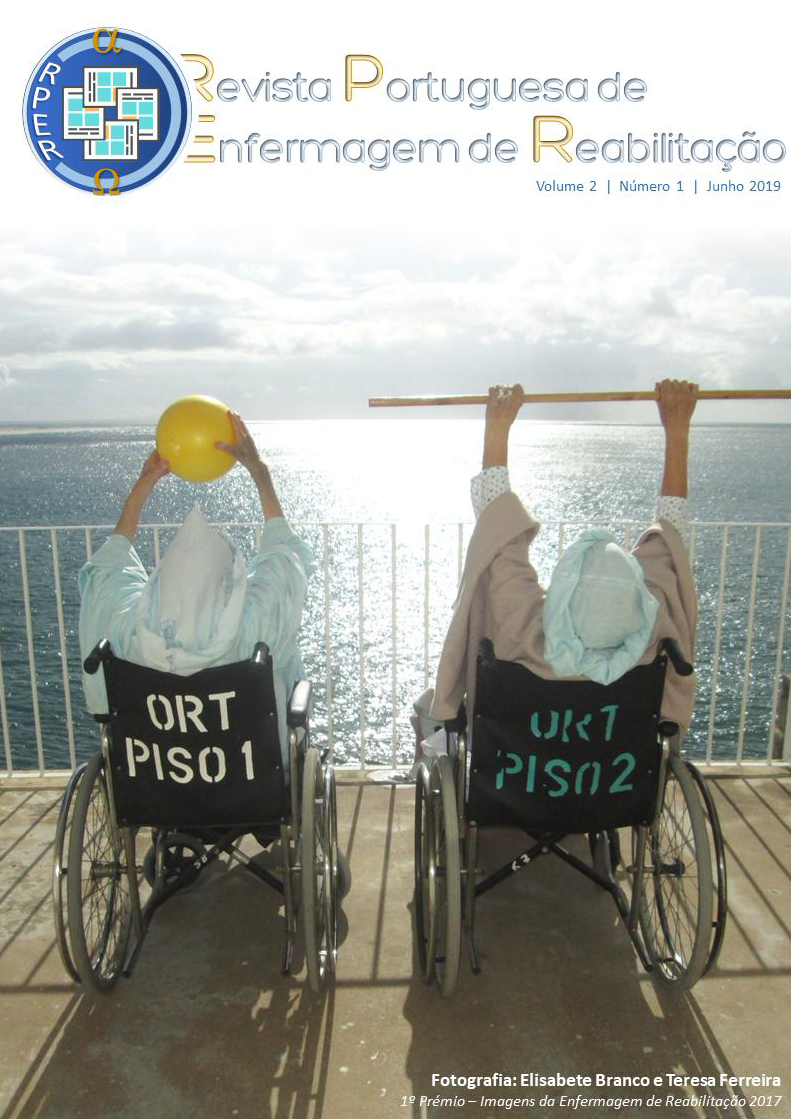Resumo
A população mundial está cada vez mais envelhecida e o risco de queda está diretamente relacionado.
O objetivo do estudo é perceber qual o efeito do treino propriocetivo e do equilíbrio postural no idoso para a prevenção de quedas.
Estudo baseado no modelo JBI. Os artigos foram extraídos das bases de dados CINAHL, MEDLINE e PEDro, redigidos em português e inglês, de janeiro de 2012 a julho de 2018, com população de 65 anos ou mais, sem condição patológica subjacente.
Incluíram-se 13 artigos que consideravam programas de treino e exercícios propriocetivos e de equilíbrio postural, força muscular, resistência, treino de marcha e a implicação sobre o medo de cair.
Concluiu-se que, a implementação destes programas, têm um impacto positivo e significativo na prevenção de quedas. Considera-se fundamental a realização de mais estudos sem recurso a tecnologia que beneficiem o treino propriocetivo e de equilíbrio postural preventivos de queda.
Referências
OMS. Relatório Mundial de Envelhecimento e Saúde. Suiça: OMS; 2015.
Marques-Vieira, C. e Sousa, L. Cuidados de enfermagem de reabilitação à pessoa ao longo da vida. 1ª Edição. Loures: Lusodidata, 2017.
Lelard T, Ahmaidi S. Effects of physical training on age-related balance and postural control. Clin Neurophysiol. 2015 Nov 1;45(4-5):357-69.
Yang XJ, Hill K, Moore K, Williams S, Dowson L, Borschmann K et al. Effectiveness of a targeted exercise intervention in reversing older people's mild balance dysfunction: a randomized controlled trial. Phys Ther. 2012 Jan 1;92(1):24-37.
Montoito, A. Fiabilidade de Testes de Proprioceptividade em Pessoas Idosas. Dissertação de Mestrado em Exercício e Saúde. Escola de Ciência e Tecnologia. Universidade de Évora. 2016.
Marques, L. Quedas são a principal causa de morte acidental dos idosos. [ed.] Jornal de Notícias. 15 de Novembro de 2017.
República, Diário da. Regulamento n.º 392/2019. Regulamento das competências específicas do enfermeiro especialista em Enfermagem de Reabilitação. 2ª série, 3 de Maio de 2019, 85.
Peters, M., Godfrey, C., Mclnerney, P., Baldini Soares, C., Khalil, H., & Parker, D. Methodology for JBI scoping reviews. Adelaide : The Joanna Briggs Insitute, 2015.
Sakamoto K, Endo N, Harada A, Sakada T, Tsushita K, Kita K, Hagino H, Sakai A, Yamamoto N, Okamoto T, Liu M. Why not use your own body weight to prevent falls? A randomized, controlled trial of balance therapy to prevent falls and fractures for elderly people who can stand on one leg for? 15 s. J Orthop Sci. 2013 Jan 1;18(1):110-20.
Clemson L, Singh MA, Bundy A, Cumming RG, Manollaras K, O’Loughlin P, et al. Integration of balance and strength training into daily life activity to reduce rate of falls in older people (the LiFE study): randomised parallel trial. Bmj. 2012 Aug 7;345:e4547.
Halvarsson A, Franzén E, Farén E, Olsson E, Oddsson L, Ståhle A. Long-term effects of new progressive group balance training for elderly people with increased risk of falling–a randomized controlled trial. Clin Rehabil. 2013 May;27(5):450-8.
Cadore EL, Rodríguez-Mañas L, Sinclair A, Izquierdo M. Effects of different exercise interventions on risk of falls, gait ability, and balance in physically frail older adults: a systematic review. Rejuvenation Res. 2013 Apr 1;16(2):105-14..
Freiberger E, Blank WA, Salb J, Geilhof B, Hentschke C, Landendoerfer P, Halle M, Siegrist M. Effects of a complex intervention on fall risk in the general practitioner setting: a cluster randomized controlled trial. Clin Interv Aging. 2013;8:1079-88.
Kim JY, Park SD, Song HS. The effects of a complex exercise program with the visual block on the walking and balance abilities of elderly people. J Phys Ther Sci. 2014;26(12):2007-9..
Roaldsen KS, Halvarsson A, Sahlström T, Ståhle A. Task-specific balance training improves self-assessed function in community-dwelling older adults with balance deficits and fear of falling: a randomized controlled trial. Clin Rehabil. 2014 Dec;28(12):1189-97.
Cho SI, An DH. Effects of a fall prevention exercise program on muscle strength and balance of the old-old elderly. J Phys Ther Sci. 2014;26(11):1771-4.
Kim WJ, Chang M, An DH. Effects of a community-based fall prevention exercise program on activity participation. J Phys Ther Sci. 2014;26(5):651-3..
Gouveia BR, Jardim HG, Martins MM, Gouveia ÉR, de Freitas DL, Maia JA, Rose DJ. An evaluation of a nurse-led rehabilitation programme (the ProBalance Programme) to improve balance and reduce fall risk of community-dwelling older people: A randomised controlled trial. Int J Nurs Stud. 2016 Apr 1;56:1-8.
Gawler S, Skelton DA, Dinan-Young S, Masud T, Morris RW, Griffin M, Kendrick D, Iliffe S. Reducing falls among older people in general practice: The ProAct65+ exercise intervention trial. Arch Gerontol Geriatr. 2016 Nov 1;67:46-54..
Lacroix A, Kressig RW, Muehlbauer T, Gschwind YJ, Pfenninger B, Bruegger O, Granacher U. Effects of a supervised versus an unsupervised combined balance and strength training program on balance and muscle power in healthy older adults: a randomized controlled trial. Gerontol. 2016;62(3):275-88.

Este trabalho encontra-se publicado com a Licença Internacional Creative Commons Atribuição-NãoComercial-SemDerivações 4.0.
Direitos de Autor (c) 2019 Revista Portuguesa de Enfermagem de Reabilitação
Downloads
| Acessos ao Resumo | 728 |
|---|
| 1735 |
|---|
| PDF (English) | 171 |
|---|





